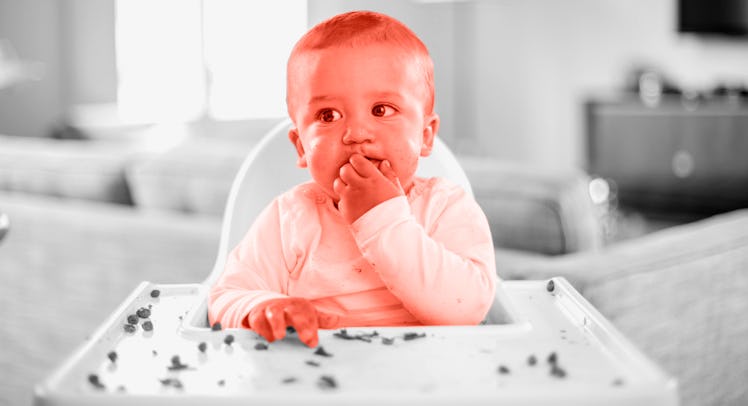How to Get a Baby to Stop Throwing Food on the Floor
It’s important for kids to play with their food. But some planning can help mitigate the messes new eaters make.

When kids begin eating solid foods it often seems like a mere ten percent ever reaches their mouths. The rest often winds up squished into the table, rubbed into their hair, smeared on the walls, or splattered on the floor. Unfortunately, these epic messes can set mealtimes up as painful points of stress, and that attitude can cause serious long-term damage to a time when parents and kids should be bonding over a meal. But while parents shouldn’t seek to end a kid’s curious food play, there are a few steps they can take to mealtimes a tad less stressful and get more food into a new eater’s mouth and off the walls and floor.
No, the mess will never be reduced to zero. And, in fact, it shouldn’t be, according to pediatric nutrition specialist and registered dietitian nutritionist Angela Lemond, owner of Lemond Nutrition in Plano, Texas. “We have to look at what food is like as a toddler,” she explains. “Just like anything else, food is a discovery for them and if they’re going to get used to different textures and flavors you have to understand that some of this playing with food is going to be an exploration for them.” Plus, Lemond explains, when children are allowed to explore and get messy with their food, they are more likely to accept new foods that are presented to them in the future.
How to Stop a Baby from Throwing Food on the Floor
- Don’t give too many snacks between meals so kids eat rather than play.
- Shift meals so they are more aligned with when a child is actually hungry.
- Don’t feed the child. Allow them to practice feeding themselves. The more they practice, the better they’ll get and the shorter the time they’ll actually be making a mess.
- There’s nothing wrong with putting down a mat to catch food and make the meal a bit more stress-free.
But new eaters aren’t just learning about accepting new flavors and textures. “They’re learning a lot of fine motor skills, so a lot of this is just about learning, developmentally,” Lemond says. Much of the inevitable mess is about learning the mechanics of eating, from bringing food filled hand to mouth, to chewing, to swallowing.
Which is all to say, a big part of parents coping with new eater food mess is to manage their own expectations and realize that there is a certain developmental beauty in the wall-splattered spaghetti. Every stain could be celebrated as a sign a kid is becoming a better eater.
Nevertheless, there are a few ways to lessen the mess, starting with knowing when a child is actually hungry. “If they’re completely playing with their food and not eating any of it then that can be a sign that they’re just not hungry,” Lemmond explains. “So a little bit of this is just gauging if they want to eat.”
RELATED: How My Kid Skipped Baby Food And Went Straight To Tacos
In other words, a hungry kid is more likely to move food to their mouths, rather than to the floor. So parents may be better off looking for signs of kid hunger to establish the earliest mealtimes rather than making arbitrary choices about when breakfast, lunch, and dinner occur. It will also help to limit snacks between meals and cut down on constant grazing so the kid arrives at the table ready to eat instead of ready to laugh wildly about watching the dog scramble for scraps.
It will also help to be prepared for the mess. The ubiquitous mealtime slop of toddlerhood has been the mother of many products dedicated to putting a barrier between the food and the floor. Washable mats installed under a high chair make clean-up a bit easier and mean that parents don’t have to white-knuckle their way through mealtime, dreading the half hour of sweeping and mopping.
But some parents just can’t help themselves. In order to further minimize mess, they may take over the feeding so everything stays tidy. But that’s a bad idea. The more they feed a child, to decrease the risk of a messy dining room of kitchen floor, the more they’re prolonging the time a child will spend making messes. That’s because kids need practice.
MORE: The Not-So-Hippy Case for Making Your Own Organic Baby Food
“They will increase with their coordination,” Lemond explains. “The more they can practice, it has a tendency to decrease the time that they are messy.”
And that’s an important point. The messy times will pass. And parents will have only a few stains and a couple pictures to remind them. So it’s best to hang in, let the kid practice feeding themselves independently, and marvel at a human discovering food.
This article was originally published on